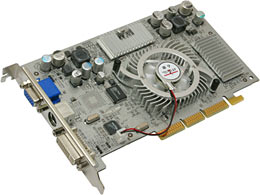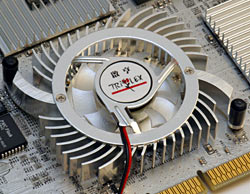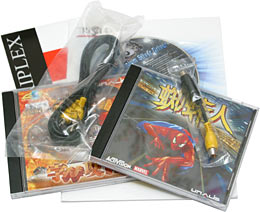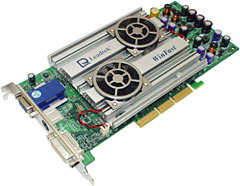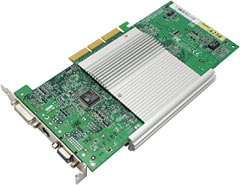
Triplex Millennium Silver 64Mb GeForce4 Ti4200 graphics card
Review date: 3 July 2002. Last modified 03-Dec-2011.
GeForce4 Titanium video cards aren't exotic any more. You can't find any that're cheap enough that they qualify as budget cards, exactly, but neither are they twice the price of a top-end Athlon, any more.
Triplex are getting themselves a reputation for decently priced, natty looking video cards, and they're slugging it out in the low-end GeForce4 market as well as selling the pricier models.
I've already reviewed Triplex's rather flamboyantly presented Ti4600 card. It's cheaper than it was when I first put that review up, but even now it's $AU693 delivered from Aus PC Market.
(Note: This review's not so young now. Aus PC don't sell these cards any more.)
That's a good price for a Ti4600 at the moment, but it's still rather more than a lot of people want to pay.
Enter the Ti4200. Most of the performance of the top-end GeForce4s, without the price.
A Triplex Ti4200 board with 128 megabytes of video RAM - the same amount as comes on Ti4400 and Ti4600 boards - is only $AU412.50, delivered.
And this Ti4200, with only 64Mb of RAM, is only $AU341 delivered.
64Mb Ti4200s are the cheapest "full" GeForce4s you can buy. The various models of GeForce4 MX are cheaper still, but they're a GeForce4 in name only; they don't have a full DirectX 8 feature set, and so are really more of a high-clocked GeForce2-and-a-half.
In the real world, the restricted feature set of the GeForce4 MX doesn't actually matter much, and they're undeniably good value for money. But if you want a proper GeForce4, the 64Mb Ti4200 is the entry level card.
The 64Mb Triplex Ti4200 doesn't have the over-the-top presentation of their Ti4400 and Ti4600 cards; it doesn't have a swoopy cooler on the main chip, and it comes in an ordinary cardboard box, not a preposterous little aluminium briefcase with a window. It's still got Triplex's signature silver circuit board, though, and so it's quite cool looking, if that sort of thing matters to you.
Triplex claim that the silver board has various advantages; less charitable people have suggested that it just costs less to make them this way. The silver finish certainly doesn't seem to hurt, though, and it's undeniably distinctive.
Extras
The Triplex software bundle isn't too foul, provided you don't want anything practical. You get Z: Steel Soldiers and Spider-Man, neither of which are particularly new but neither of which are rubbish, either.
There's also a driver disc containing Triplex-branded drivers for their whole Nvidia-chipset card range, and a selection of not terribly compelling utilities. You can safely leave this disc in its plastic sleeve, and just install the Nvidia reference drivers instead. That's what I did.
Along with the software, you get an RCA composite video cable for connecting the card to a TV, VCR or other composite device, and a little adapter lead that lets you plug the RCA cable into the S-Video TV out connector on the back of the card. There's no S-Video lead, and there's no adapter for the Digital Visual Interface (DVI) connector on the back of the card, either. So you can plug a normal VGA-connector monitor into the 14 pin socket on the back of the card, but if you want to do dual monitor computing (which the Ti4200 supports, just like the Ti4400 and Ti4600), you'll either need your second monitor to be a flat screen with a DVI connector, or you'll have to shell out for a DVI-I to VGA adapter so you can connect another analogue-cable screen.
Performance
The different models of full GeForce4 may differ substantially in price, but they're not actually that far apart in performance.
The normal stock speed for 64Mb Ti4200 cards is 250MHz core, 500MHz RAM. 128Mb Ti4200s get slower RAM, and run at 250/444MHz. Ti4400s are meant to be 275/550MHz, and Ti4600s are meant to be 300/650MHz. So, at stock speed, the fastest full GeForce4 is only 20% and 30% higher clocked than the slowest one.
The Triplex 64Mb Ti4200 is clocked at 250/550MHz by default, giving it almost Ti4400 performance out of the box. The higher RAM speed's accounted for by the non-standard memory chips Triplex have put on the card; they're rated at 3.3 nanoseconds (ns), which means their specified ceiling speed before DDR doubling is 300MHz. After doubling, 600MHz.
Triplex's 128Mb Ti4200 card, by the way, runs its RAM at 500MHz (after DDR doubling) by default, which is right on the specified ceiling of the 4ns chips.
Just because RAM is rated to manage a certain speed doesn't mean it can do it on a particular video card, though. It's common enough to find that some other factor limits the card performance before you hit the RAM's alleged performance ceiling.
I'm happy to say, though, that this card doesn't have any such problems. Well, the one I got for review doesn't, anyway. Its memory was happy at 625MHz, and I managed to wind its core up to 315MHz, which is as far as the standard Nvidia clock speed slider will go. You can push further if you use third party utilities, but core speed has a small enough influence on performance that there's not a lot of point bothering. 315MHz from a Ti4200 is a perfectly good result.
And I did the tests in an unheated room on a rather chilly night, anyway; that might have raised the core speed headroom a little.
The 3.3ns RAM on this card doesn't seem to give it a significant advantage over normal 64Mb Ti4200s. Anand managed to get a couple of 64Mb Ti4200 boards with the standard RAM to 600 and 610MHz; 625 isn't enough faster that you should care.
Fully overclocked, this cheapo 64Mb Ti4200 is faster than a 128Mb Ti4600 running at stock speed. Well, it is unless you need more than 64Mb of video memory, anyway. Run out of graphics card memory and you'll be using AGP texturing, which'll cause your 3D frame rate to plunge.
It's not at all hard to keep all current games inside a 64Mb video card memory budget, though. You can exceed it with some recent titles if you wind up all of the texture detail settings to max and turn off texture compression.
So don't do that.
What difference does the clock speed change actually make, though?
Not a whole lot.
I tested the Triplex card on Fairly Darn Fast Box of the moment, which has a Palomino-core Athlon XP running at 1491MHz, from a 142MHz FSB, on an Abit KR7A-RAID, with 512Mb of DDR memory.
At stock speed, the Ti4200 card scored an average of 8407 3DMarks over five runs of the default 3DMark2001 SE benchmark, using the latest-as-I-write-this v29.42 Detonator drivers.
You need to do multiple test runs with 3DMark2001 if you want a decently accurate result, because this benchmark has a bit of variance. If you're wondering where that comes from, pay careful attention to the barrel(s) bouncing around in the very first "Car Chase - Low Detail" test. Sometimes the truck hits a barrel after missiling the first flying bad guy, sometimes it doesn't. Sometimes the rolling barrel isn't even there for the truck to hit. In the next shot, one, two or no barrels can be rolling and bouncing around as the truck handbrake-turns into the next corner.
I don't know if any of the other tests have similar variability, and the variance is only slight; test runs seem to all be between about 1.5 and about 0.1 per cent of the average value, so a single test run will give you a decent result. When you're playing with small video card overclocks, though, 1.5 per cent up or down can significantly inflate or depress your results.
If you're thinking that a 1.5 per cent difference doesn't sound like much, and that the benefits to be gained from overclocking therefore seem rather underwhelming, you're right. At 315/625MHz, the Triplex card scored an average of 9161 3DMarks, almost 9% better.
Since this is for un-antialiased operation in 1024 by 768, 32 bit colour, it's a worthwhile improvement; use full-scene anti-aliasing (FSAA) or very high resolutions and you'll get improvements significantly above the magic 10% point. 10% is the rule-of-thumb point above which you can actually notice a difference.
Even if you get a 15% improvement, though, it's really not anything to get hot and bothered about. Noticeable? Probably. Dramatic? Definitely not.
Here, for comparison, is my own GeForce4. It's a Leadtek Ti4400, sporting their inimitable Enormous Heatsink With A Small Parasitic Video Card Attached To It design philosophy.
This card, and its identical-looking Ti4600 sibling, are easily the heaviest consumer video cards on the market today, and look right impressive in a windowed case. They'll set you back $AU555.50 and $AU726 from Aus PC Market, respectively, including Australian delivery.
The Leadtek Ti4400 defaults to 275/552MHz; its reliable ceiling seems to be about 285/680MHz. At that speed in the default 3DMark2001 SE benchmark, it manages 9035 3DMarks, a trivial amount below the score of the overclocked Triplex Ti4200. In higher resolutions, the Leadtek card's faster RAM would outweigh its slower core and let it get ahead by a little, but the clock speed differences are less than 7% for core and less than 9% for RAM, so there's never going to be enough between the two for it to matter. Newer Leadteks may have more overclockable cores - the cooling system certainly isn't the limiting factor - and end up ahead of the Triplex Ti4200s across the board. But the difference still isn't going to be enough to justify the extra money.
Overall
What all this means is that 64Mb Ti4200s are a good deal in general, and the Triplex 64Mb Ti4200 is a good deal in particular. If you must have 128Mb of video memory then the somewhat more expensive 128Mb Triplex Ti4200 will suit you; its RAM is slower, but it really won't make enough difference to matter to anybody who's not pathologically picky.
For most people, though, the cheaper 64Mb version is a great deal. Full GeForce4 features, and enough RAM for every current game and plenty to come, provided you don't have to turn every pretty-setting to the absolute maximum. And a price that's dipping down into genuine bargain territory.
If you've been putting off buying a GeForce4 Titanium until they stopped being so foolishly expensive, now is the time to let the moths out of your wallet.
Recommended.
